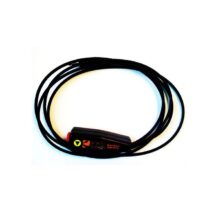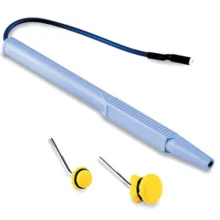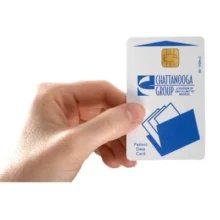Bifurcated Dispersive Lead
Se connecter pour obtenir les prix des revendeurs
| Couleur | Vert |
|---|---|
| Dimensions du produit | 18″ Length |
The Chattanooga bifurcated dispersive lead is for use with Intelect IFC units
Interferential Current (IFC) therapy is a form of electrical stimulation used in physical therapy and rehabilitation to manage pain, reduce muscle spasms, and promote tissue healing. A bifurcated dispersive lead is a specific type of electrode setup commonly used in IFC therapy.
How A Bifurcated Dispersive Lead Is Used In IFC Therapy
IFC Therapy Basics
- IFC therapy involves the use of two medium-frequency alternating electrical currents that are slightly out of phase with each other. These two currents intersect at the target area within the body, producing a low-frequency interference pattern.
- The interference pattern creates a sensation that can help relieve pain, stimulate muscle contractions, improve blood flow, and reduce inflammation.
- In IFC therapy, the treatment typically requires the use of two sets of electrodes: one for delivering the primary current and another for the secondary current. The electrodes are placed on the patient’s skin around the area of treatment.
Electrode Placement
- The bifurcated dispersive lead consists of two pairs of electrodes, each connected to one of the two electrical currents generated by the IFC machine.
- One pair of electrodes is positioned at the treatment site where the therapeutic effect is desired. These are often referred to as the “active” or “treatment” electrodes.
- The second pair of electrodes serves as the dispersive lead and is strategically placed away from the treatment site. These electrodes complete the circuit for the electrical currents, allowing them to flow from the treatment electrodes through the targeted tissues and back to the dispersive electrodes.
- The distance and positioning of the dispersive electrodes help control the depth and area of penetration of the electrical currents, allowing for a more targeted and effective therapy.
Advantages of Bifurcated Dispersive Lead Use
- Enhanced Targeting: The use of a bifurcated dispersive lead helps focus the therapeutic effect on the desired treatment area, increasing its precision and effectiveness.
- Comfort and Safety: By separating the active treatment electrodes from the dispersive electrodes, the risk of discomfort or skin irritation at the treatment site is reduced. This also helps ensure that the patient’s skin is not subjected to excessive electrical energy.
- Improved Penetration: The configuration of the dispersive lead allows for better penetration of the electrical currents into the deeper tissues, which can be especially beneficial for managing pain and promoting healing.
In summary, a bifurcated dispersive lead is an essential component of IFC therapy. It allows for the safe and effective delivery of medium-frequency alternating currents to the target area while minimizing discomfort and ensuring precise targeting. Proper electrode placement and setup, including the use of a dispersive lead, are key factors in achieving optimal outcomes in IFC therapy. This treatment approach is typically administered by trained healthcare professionals, such as physical therapists, who can tailor the parameters to the patient’s specific needs and condition.





Commentaires
Il n'y a pas encore de commentaires